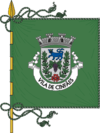Cinfães
| Cinfães | |||
|---|---|---|---|
| Municipality | |||
| |||
 | |||
| Coordinates: 41°06′N 8°08′W / 41.100°N 8.133°WCoordinates: 41°06′N 8°08′W / 41.100°N 8.133°W | |||
| Country |
| ||
| Region | Norte | ||
| Subregion | Tâmega | ||
| Intermunic. comm. | Tâmega e Sousa | ||
| District | Viseu | ||
| Parishes | 14 | ||
| Government | |||
| • President | José Manuel Pinto (PS) | ||
| Area | |||
| • Total | 239.29 km2 (92.39 sq mi) | ||
| Population (2011) | |||
| • Total | 20,427 | ||
| • Density | 85/km2 (220/sq mi) | ||
| Time zone | WET/WEST (UTC+0/+1) | ||
| Website | http://www.cm-cinfaes.pt | ||
Cinfães (Portuguese pronunciation: [sĩˈfɐ̃jʃ]) is a village and a municipality in the northern district of Viseu, Portugal. The village proper has about 3,300 inhabitants. The population of the municipality in 2011 was 20,427,[1] in an area of 239.29 km².[2]
Its history is linked to the Knights Templar, who had strongholds in Cinfães such as "Torre da Chã" or "Torre dos Pintos"; and also the story of the childhood of King D. Afonso Henriques and his server Egas Moniz. It has an important heritage resource, especially the Romanesque churches such as St. Cristóvão de Nogueira; Lady of Cales or Cadiz, among many important others.
The present mayor is José Manuel Pereira Pinto, elected by the Socialist Party. The municipal holiday is June 24.
Parishes
Administratively, the municipality is divided into 14 civil parishes (freguesias):[3]
- Alhões, Bustelo, Gralheira e Ramires
- Cinfães
- Espadanedo
- Ferreiros de Tendais
- Fornelos
- Moimenta
- Nespereira
- Oliveira do Douro
- Santiago de Piães
- São Cristóvão de Nogueira
- Souselo
- Tarouquela
- Tendais
- Travanca
References
- ↑ Instituto Nacional de Estatística
- ↑ Direção-Geral do Território
- ↑ Diário da República. "Law nr. 11-A/2013, page 552 40" (pdf) (in Portuguese). Retrieved 21 July 2014.
External links
| ||||||

